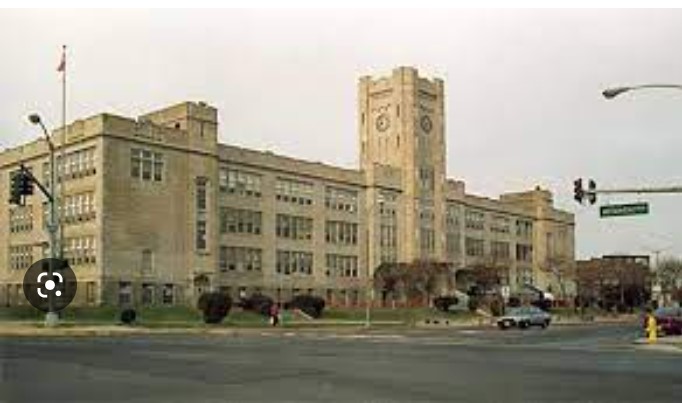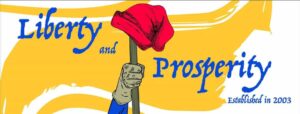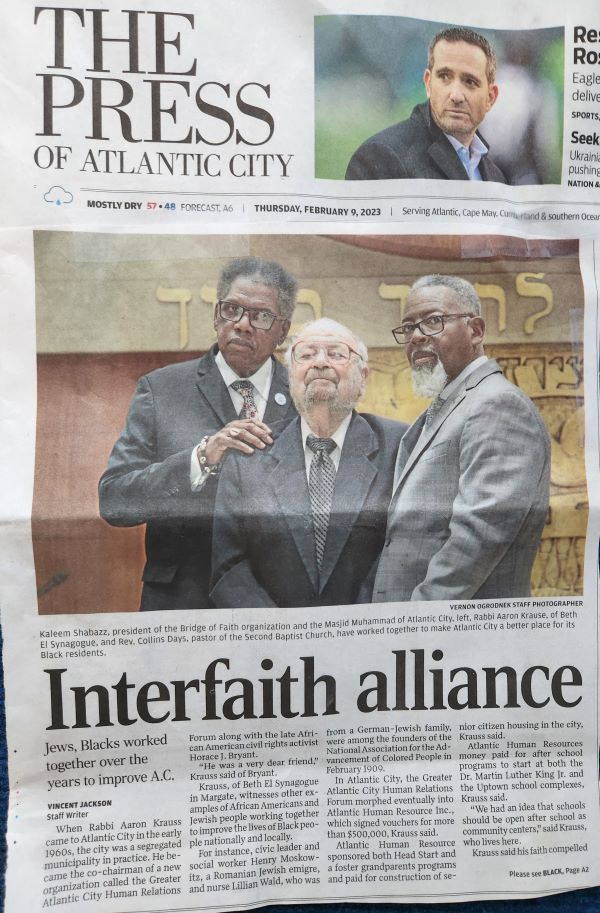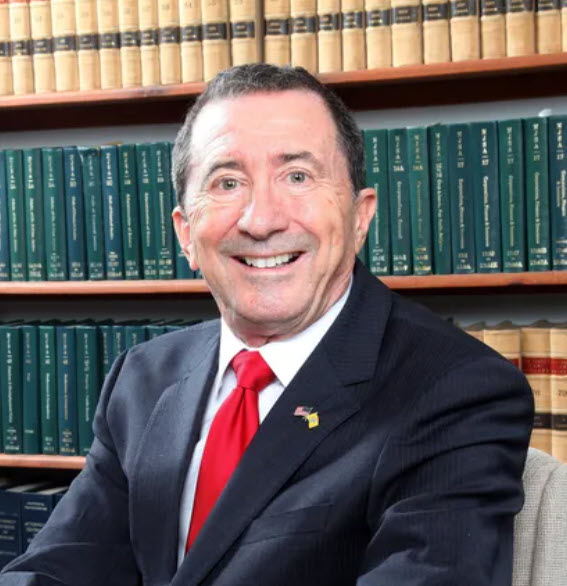Last Thursday, this article on the front page of the The Press of Atlantic City paid tribute to local Rabbi Aaron Kraus on his 93rd birthday. The headline is “Interfaith alliance. Jews, Blacks worked together over the years to improve Atlantic City”. Beneath the above photo, the caption reads “Kaleem Shabazz, president of the Bridge of Faith organization and the Masjid Muhammad of Atlantic City, Rabbi Aaron Krauss of Beth El Synagogue, and Rev. Collins Days, pastor of the Second Baptist Church have worked together to make Atlantic City a better place for its Black residents.
Click Here For Link To February 9 Article In Press of Atlantic City: Jews and Africans Americans worked together over the years to improve Atlantic City (pressofatlanticcity.com)
However, that “Interfaith Alliance” did not “improve” Atlantic City. It helped ruin it. Atlantic City is NOT “a better place” for its Black residents than it was in the 1960’s. Like most inner cities in America today, it is a far worse place.
I grew up in Atlantic City in the 1950’s and 1960’s before Rabbi Krauss moved to Atlantic City and began his work.

Above Image: This Atlantic City High School, built in 1923, was one of the finest high schools in America for the next forty years. Foreign diplomates in Washington, D.C., often established residency in Atlantic City, NJ so they could send their children here. Like Atlantic City’s previous high schools built in 1895 and 1901, it was always open to children of all races.
- At that time, Atlantic City had some of the best schools in the country. Children attended elementary schools in their neighborhood. Most, but not all Blacks and Whites lived in separate neighborhoods. Most, but not all, neighborhood elementary schools were almost all White or all Black. In the mixed neighborhood of Venice Park, most Black students went to a nearby all Black Indiana Avenue elementary school while most Whites went to nearby Brighton Avenue School, which was mostly White. However, there were Black and White students in the Massachusetts Avenue School which served the integrated Inlet area. And we all went to the same completely integrated junior high school in seventh grade. Then we went to the same completely integrated Atlantic City High School.
2. There were few public housing projects, and most people who lived there moved out as soon as they got back on their feet. Most Black families owned their homes. Many Black families also owned apartments that they rented out.

Chalky White is a character in the fictional HBO TV series Boardwalk Empire. However, his character is based on the historically true stories of many Black Americans who moved up from the South to establish successful businesses in Atlantic City since the 1890’s. When “progressive” politicians made gambling and liquor sales illegal starting in 1908, Black and White business owners who served tourists stayed in business by defying those new laws. Democratic President Woodrow Wilson, one of those “progressives”, was Governor of New Jersey from 1911 to 1913.
3. There were dozens, if not hundreds of black owned businesses in Atlantic City. Back in 2010, Ralph Hunter of the African-American Heritage Museum of South Jersey named and described many of them in great detail at an event at the Tropicana Casino when the HBO TV series Boardwalk Empire was introduced. They included the Black owned Apex Community Drug Store owned by local Black local multi-millionaire Sarah Spencer Washington and retail shops, restaurants, hotels, bars, and night clubs. They included construction, electrical and appliance installation and repair businesses. There were respected and prosperous Black doctors, teachers, managers, supervisors, repair, doctors, teachers, police officers, and firefighters. The Chalky White character of Boardwalk Empire was based on historical fact, and fit the profile of many of the successful Blacks who established those businesses in the early 1900’s.
4. Most black parents were married, and active in churches, and fraternal, charity, and civic associations. They were trained, experienced, and disciplined in running those organizations. They held productive meetings, maintained records, collected dues, sponsored events and projects, and raised funds without government funding, lawyers or other outside “experts”.
5. Most parents were also active in the Parent Teacher Association (PTA) f their children’s schools. There was discipline and respect in the public schools. There were many excellent Black and White teachers because teachers were hired by merit and achievement–not politics or “Diversity Equity and Inclusion” (DEI) goals. Most of the critical thinking, math and writing skills that helped me succeed as a lawyer were taught to me by Alice Carter, Marvin Hill, and Edgar Harris. They were three Black teachers who taught me at Central Junior High School and Atlantic City High School in the early 1960’s.
6. It was safe for anyone to walk freely in any neighborhood day or night. I often safely walked barefoot on the sidewalks of my neighborhood–which included the busy commercial street of Pacific Avenue. We often slept in our homes on hot summer nights with doors and windows wide open, with only flimsy screens and screen doors to block access.
7. I was a member of our local Atlantic City National Guard Unit. 5th Battalion, 112 Artillery at New York Avenue and Absecon Boulevard for six years. That unit began as an “colored” unit in the 1920’s. Carl Briscoe, a Black man was our commanding officers for most of that time, and his brother Richard was my First Sergeant. Most of our sergeants were Black. Most were married, owned their homes, and were the successful owners or managers of private businesses,, ofr police officers or firefighters. Most were also leaders in their churches or fraternal groups. They were capable, honest, efficient, and fair.
8. I was not an athlete and know very little about athletics at the time. However, I do know that Whites liked Pinky Kravitz, and Blacks like Gene Hudgins were very active in all sorts of sports activities open to athletes of all races.
9. Both the Black and White communities depended on earning a year of income from tourists during a four month tourist season. We all had an interest in keeping the Boardwalk and the streets clean and safe, and they were. We also decorated the town for Christmas. There was nothing more beautiful than the Christmas light display in the park in front of the old Atlantic City High School.
During this time, Atlantic City politics was roughly evenly divided between Republicans and moderate John F. Kennedy Democrats.
Last Thursday’s front page article in the Press of Atlantic City tells of how Rabbi Krauss moved to Atlantic City and become the rabbi of the old uptown Community Synagogue in 1962. One year later, President Kennedy was murdered and replaced by “progressive” Democratic President Lyndon Johnson. In 1965, Johnson started a massive expansion of the welfare state which he called the “War on Poverty” and the “Great Society”. The article tells of how Rabbi Krauss then worked with a Horace Bryant, a Black political power broker who was active in the Democratic Party. During the next five years, the two were leaders of several “non-profit” and “community ” organizations that lobbied and applied for and spent massive amounts of federal government money.
These programs, and the new generation of Black leaders who ran them had a devastating impact on Atlantic City in general, and its Black neighborhoods and communities in particular.
- This new generation of Black and White teachers and school administrators brought “Black Liberation” and “Black Power” ideas and methods to Atlantic City’s public schools. These methods included “homogenous grouping” in which students were no longer placed in classes based on their academic achievement. High and low achievers were placed in the same classes, and taught at the same levels. This greatly reduced academic performance and discipline in the Atlantic City Public Schools. One school administrator who pushed these reforms was Oscar Harris. Years later, in 2004, Harris was convicted on fraud charges involving “fictitious money orders” for a radical “Black liberation” group called the “Al Moroccan Empire” or “Moors”.
- Democrat Horace Bryant and others were influential in bringing new “Tenant Protection” and “Rent Control” laws to Atlantic City. When Horace Bryant became a City Commissioner in 1972, he created a new Rent Control Department and hired his daughter, Lillian Bryant to run it. These laws made it difficult and expensive to evict tenants who did not pay their rent, damaged property, or disturbed neighbors. They also made it difficult, expensive, or impossible to raise rents when needed to pay expenses. As a result, many landlords were forced out of business, and their properties were abandoned. Many, if not most of those landlords were black. This rental housing was then replaced by massive amounts of public or “affordable” housing paid for by federal and state government. Many of these new housing projects were fully or partly exempt from real estate taxes. This raised taxes for all other real estate in Atlantic City.
- There was a sharp increase in crime and vandalism in Atlantic City between 1965 and 1971., which greatly hurt the summer tourist business. That business was crippled by nationwide news coverage of a tourist who was shot and killed on the Boardwalk in 1971. In 1976, the YMCA in the heat of Atlantic City’s business shut down. The building was converted to a government funded narcotics rehabilitation center dispensing methadone to drug addicts. This further hurt tourism.
- Massive amounts of federal money eliminated the need for self-sufficient leaders of volunteer church, fraternal and civic associations in Atlantic City. Getting money to help those in need no longer depended on forming large organization, collecting dues and sponsoring charitable events. Far more money would be raised by getting out the vote and electing “progressive” Democrats. Winning elections guaranteed more funding for government programs that gave money to selected organizations that filled out the necessary grant application forms.
- When large segments of Atlantic City’s Black community no longer depended on tourists, the leaders who represented them no longer found it important to keep the Boardwalk and streets clean and safe for tourists.
- The new federal welfare programs gave numerous benefits to unmarried women with children. Those benefits included cash payments, food stamps, free medical care, and reduced rent. This made it possible for women to raise children without fathers in the home.
- The new federal programs also radically changed the work ethic within the Black community. Until the 1960’s, Black and White Americans agreed that the best way to earn money and achieve success was to work, save, get married, and get an education and training. However, after the “War on Poverty” and “Great Society”, there quicker and easier ways to earn money within the Black community. One was to go into politics and win elections. The other was to to threaten violence or riots if demands were not met. Those demands usually involved funding organizations that would use that money to pay salaries and other benefits to their leaders. Those new political leaders included
- .Another new federal program was “Urban Renewal”. In 1967, the Federal government funded an “Urban Renewal” project for 80 acres in the heart of Atlantic City.. That area included States Avenue, a beautiful tree lined street of elegant Victorian homes and hotels. If was very similar to the Victorian areas preserved in Cape May. Every home and business within those 80 acres was declared “blighted” and condemned. The Atlantic City Housing and Redevelopment Authority used “Eminent Domain” force every owner of real estate there to sell to the government, and every residential and commercial and residential owner and tenant to leave the area.
- By the early 1970’s, a new type of community and political leader represented most of the Black community in Atlantic City. They included people like Harold Mosee, Israel Mosee, Oscar Harris, Horace Bryant, Lillian Bryant, Kaleem Shabazz and Barbara Woodall. Unlike previous Black leaders, they did not own businesses and were not established teachers, administrators, police officers or firefighters. Their income was totally dependent on politics and organizations funded by government grants. The older, established Black leaders opposed them at first. Last Thursday’s article in the Press of Atlantic City gave a very misleading description of them. According to the article:
“During the 1960’s in Atlantic City, there was a group called the “Stand-Patters”, who rejected (Democrat) Horace Bryant’s strides towards racial equality. But African-African Americans were represented eventually in elected positions at City Hall and became able to buy homes in the city outside of the Northside, Krauss said. Working to make these changes did not come without opposition Krauss said.”
Anyone reading this who is not familiar with Atlantic City history would mistakenly think that the “Stand-Patters” were some white supremacist group! However, the “Stand-Patters” were Black! They were older, experienced Black leaders who had succeeded in business or professional careers and who had led successful independent, self-funded church, fraternal or civic organizations before getting involved in politics.
Sadly, these “Stand Patters” never had a chance. They were attacked, ridiculed, and vilified as “Uncle Toms”. The new Black political leaders who did it had none of the practical life experiences of the people they attacked. The new leaders were trained, supported, and funded by Democratic Party politicians and government officials.
Click Here For Details Of Atlantic City’s Black Community Before The 1960’s:
See also book By Turiya S.A. Raheem in Growing Up In The Other Atlantic City. (2009)
LibertyAndProsperity.com is a tax-exempt, non-political education organization of roughly 200 citizens who mostly live near Atlantic City, New Jersey. We formed this group in 2003. We volunteer our time and money to maintain this website. We do our best to post accurate information. However, we admit we make mistakes from time to time. If you see any mistakes or inaccurate, misleading, outdated, or incomplete information in this or any of our posts, please let us know. We will do our best to correct the problem as soon as possible. Please email us at info@libertyandprosperity.com or telephone (609) 927-7333.
If you agree with this post, please share it now on Facebook or Twitter by clicking the “share” icons above and below each post. Please copy and paste a short paragraph as a “teaser” when you re-post.
Also, because Facebook and Twitter falsely claim our posts violate their “community standards”, they greatly restrict, “throttle back” or “shadow ban” our posts. Please help us overcome that by sharing our posts wherever you can, as often as you can. Please copy and paste the URL link above or from the Twitter share button to the “comments” section of your favorite sites like Patch.com or PressofAtlanticCity.com. Please also email it to your friends. Open and use an alternate social media site like Gab.com.
Finally, please subscribe to our weekly email updates. Enter your email address, name, city and state in the spaces near the top of our home page at Homepage – Liberty and Prosperity. Then click the red “subscribe” button. Or email me at sethgrossman@libertyandprosperity.com or address below. Thanks.
Seth Grossman, Executive Director
LibertyAndProsperity.com
info@libertyandprosperity.com
(609) 927-7333


